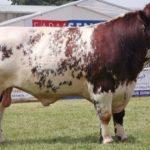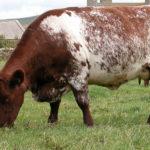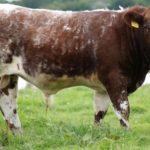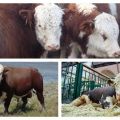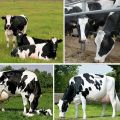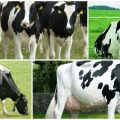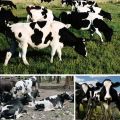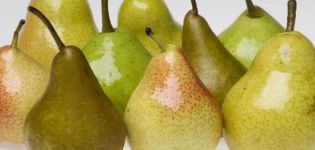Description and characteristics of cows of the Shorthorn breed, breeding rules
Great Britain is considered the homeland of the Shorthorn breed of cows. The new species was bred by crossing the local livestock with Dutch bulls. At first, the goal of the English breeders was to improve the meat characteristics, but then they paid attention to the milk performance. Today cows are bred by farmers in Europe, Canada and other countries. Animals were brought to Russia in the 19th century.
Appearance and characteristics
The Shorthorn breed got its name from its short and curved horns. The cows are well proportioned. The animals are rather large - up to 130 centimeters in height, the oblique body length exceeds one and a half meters. The color of the coat is red, there are variegated specimens, and sometimes pure white.
Adult females weigh about half a ton, bulls - 7-9 centners. Calves are born 30 kg. Russian representatives of the breed are larger. The weight of cows reaches 6 centners, of producers - almost a ton.
The meat yield from the Shorthorn breed is 60-80%. The share of body fat is no more than 8%. The products are of the marble type. The animals reach the highest productivity at the age of 2 years. They also receive 2500 liters of milk with a fat content of 3.9% per year.
Pros and cons of the Shorthorn cow
The Shorthorn cows have advantages and disadvantages over other species:
The meat of Shorthorn cows is valued for its taste and marble layer. But susceptibility to disease and low fertility led to the fact that the number of livestock decreased.
Requirements for maintenance and care
Cows require careful grooming. The Shorthorn breed does not tolerate cold and does not adapt well to climatic conditions. If you do not pay enough attention to the livestock, animals often start to get sick.
Bulls lose the ability to mate, females lose the ability to fertilize. Productivity rates are also starting to decline.
In conditions of southern heat, it is recommended to release Shorthorns to pastures in the spring and summer. In cool climates, animals spend most of their time in the pen. Make sure the room is warm and dry. Drafts are contraindicated.

In front of the building, an area with a canopy for walking is being arranged. Staying in the fresh air will have a positive effect on the well-being of the cattle.To strengthen the immune system, it is useful for cows to move for at least 3 hours. This is enough time to put things in order in the barn.
Diet
To the nutrition of the Shorthorn breed, increased demands are made. The use of low-quality feed is reflected in the weight gain of animals. The diet includes:
- Hay and straw. In winter, the volumes are increased.
- A favorite treat for cows is legumes. The pasture provides only a quarter of this type of grass for the livestock. When breeding Shorthorns, it is recommended to plant separate areas with plants.
- From root crops, animals prefer beets, carrots. Potatoes, pumpkin and silage are useful.
- Different types of concentrates are mixed in equal parts. Usually 2 types of products are used.
- The need for nutrients is provided by vitamin and mineral complexes.
Shorthorns eat at least 55 kilograms of food per day. In the diet of bulls, roughage makes up a third of the total volume of products, and juicy - half the daily requirement. For females, these types of food are distributed equally.

Breeding the breed
Breeding cows of the Shorthorn breed is difficult due to the difficulties with fertilization. Various pathologies often reduce the fertility of animals. But with a successful conception, calving is easy. During pregnancy and in the postpartum period, they provide comfortable housing for the cow and calf. Violation of hygiene standards will lead to disease and even death of livestock. Youngsters are immediately taught to observe the daily routine. Walking and feeding is carried out strictly on schedule.
Frequent illnesses
The health of cows of the Shorthorn breed is poor. Animals are susceptible to infections and viruses. The most dangerous ailments are leukemia and tuberculosis. An effective treatment has not yet been developed. At the first sign of illness, infected individuals are immediately isolated from the herd. The carcasses are burned. Antibiotics are used to combat leptospirosis and catarrhal fever.
When breeding animals, attention is paid to the quality of food, water and keeping the pen clean. As a preventive measure, regular vaccinations and veterinary examinations are carried out.
Shorthorn cows have many positive qualities. Breeders use the breed to develop new productive species. Subject to the rules of keeping and feeding, large volumes of quality meat and milk are obtained.
